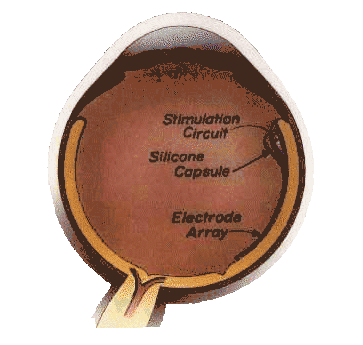The
Retinal Implant Project.
 [D]
[D]
The
Retinal Implant Project.
 [D]
[D]
The Retinal Implant Project began in 1989 as a Massachusetts Eye and Ear Infirmary/Harvard Medical School and Massachusetts Institute of Technology collaboration. The project seeks to develop a silicon chip eye implant that can restore vision for patients suffering from Retinitis Pigmentosa and Macular Degeneration.
Age-related Macular Degeneration is the leading cause of blindness. This central loss of vision often makes it difficult to impossible to perform detailed work such as reading. Retinitis Pigmentosa ranks number one in the world as a genetic form of blindness, denying approximately 1.2 million people sight. Peripheral vision goes flat followed by gradual loss of central or reading vision.
Blindness can result from corneal diseases, cataracts or diseases affecting the retina, optic nerve or brain. Retina diseases such as Macular Degeneration and Retinitis Pigmentosa involve only the rods and cones while cells that connect the eye to the brain remain healthy.
The chip under design will rest on the inside surface of the retina, opposite the damaged rods and cones and in contact with the relay cells to the brain. The use of an implant to bypass the damaged rods and cones is an approach that mirrors the way the renowned cochlear implant project has restored hearing to deaf patients.
The implant will contain two silicon chips, both within the "silicone capsule." The top chip will receive light entering the eye, initially from a tiny laser affixed to a pair of glasses.
A small CCD camera will also reside on the glasses to convert the visual scene to a series of laser pulses that will invisibly carry power and visual signals into the eye. The second chip, the circuit chip, will decode the laser's visual information, much as a TV set decodes the airwave signal.
The visual signal will be sent to an "electrode array" that will transmit electric pulses to the eye's nerve cells.
A tiny solar panel solves the problem of supplying energy. Jim Mann, Terry Hernden and Tony Soares at MIT-Lincoln Labs were instrumental in the design, fabrication and testing of the solar panel. Light striking the panel causes ionization which produces charged ion pairs or current. Voltage depends on the light's wavelength and intensity. Using near infrared wavelengths at intensities believed to be safe for the eye, the photodiode array delivers approximately seven volts, slightly more than needed to power the circuit chip that will transfer the visual signal to the retina. Both the solar panel and circuit chip will be contained within a capsule. The solar panel measures 2 by 2 millimeters and consists of 12 photodiodes made of silicon connected in series.
I wish the inventors of this implant the very best luck
with their fantastic Retinal Implant Project and I know that many
people worldwide will have their lives changed forever by this implant.
I wish them and their future patients very good luck with it.